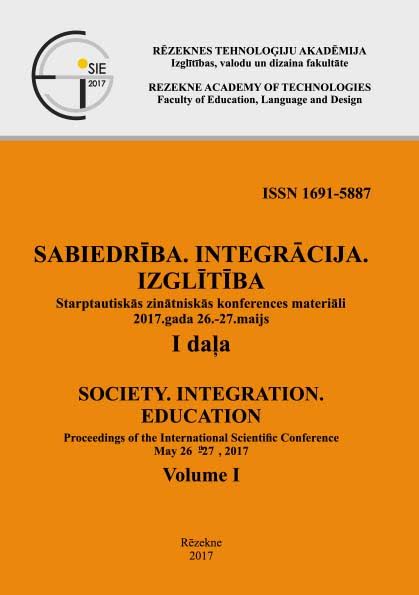PREDICTORS OF THE SENSE OF BELONGING TO THE COUNTRY: EXPLORING A NEW MODEL
DOI:
https://doi.org/10.17770/sie2017vol1.2325Keywords:
community, country, ecological systems theory, opportunities, sense of belongingAbstract
This study explored new possibilities for measuring the sense of belonging to the country and investigated predictors of the sense of belonging to Latvia. Focusing on students’ sense of belonging to the country is explained by two reasons: 1) emigration is the main factor of depopulation in Latvia; 2) students’ intention to emigrate is the highest among other social groups. Studies in the field of community psychology present models of the sense of community and explore intentions to stay in a particular place. Within a new model, different levels of social systems (from meso- to macro-system) were included into the analysis of predictors of the sense of belonging to the country. The participants were 205 university students from 18 to 30 (67% females). On the basis of previous studies, a new measure of the sense of belonging and perceived context was developed. The results confirmed a complex model of the sense of belonging in the context of social systems. Higher perceived opportunities at the level of the country and more positive evaluation of the future of Latvia predicted higher level of the sense of belonging to Latvia directly. In addition, female students perceived higher level of the sense of belonging than male students.Downloads
References
Arcidiacono, C., Procentese, F., & Di Napoli, I. (2007). Youth, community belonging, planning and power. Journal of Community & Applied Social Psychology, 17, 280–295.
Bronfenbrenner, U. (1979). The ecology of human development: Experiments by nature and design. Cambridge, MA: Harvard University Press.
Central Statistical Bureau of Latvia (2014). Income and living conditions in Latvia, 2013. Collection of statistical data (14). Riga: CSB of Latvia. Retrieved from http://www.csb.gov.lv/sites/default/files/nr_14_ienakumi_un_dzives_apstakli_latvija_2013_14_00_lv_en.pdf
Central Statistical Bureau of Latvia (2016). Demography 2016. Collection of statistical data. Riga: CSB of Latvia.
Dekel, R., & Nuttman-Shwartz, O. (2009). Posttraumatic stress and growth: The contribution of cognitive appraisal and sense of belonging to the country. Health and Social Work, 34, 87-96.
Eurostat, European Commission (2016). Population (Demography, Migration and Projections) [Interactive map]. Retrieved from http://ec.europa.eu/eurostat/web/population-demography-migration-projections/statistics-illustrated
Hazans, M. (2013). Emigration from Latvia: Recent trends and economic impact. In OECD, Coping with Emigration in Baltic and East European Countries (pp. 65-110). Paris: OECD Publishing. http://dx.doi.org/10.1787/9789264204928-7-en
Huddy, L., & Khatib, N. (2007). American patriotism, national identity, and political involvement. American Journal of Political Science, 51, 63-77.
Kolesovs, A. (2015). Prediction of distant educational goals by goals in other domains and perceived contextual opportunities. In V. Lubkina, & S. Usca (Eds.), Society, Integration, Education: Vol. 4. Proceedings of the International Scientific Conference (pp. 40-47). Rēzekne: Rēzeknes Augstskola.
Kolesovs, A., & Kashirsky, D. V. (2014). Anticipated future of Latvia and Russia during a global economic crisis: A mixed methods perspective. Psihologija, 47, 153-167.
McMillan, D. W., & Chavis, D. M. (1986). Sense of community: A definition and theory. Journal of Community Psychology, 14, 6-23.
Miller, L. (2003). Belonging to country – A philosophical anthropology. Journal of Australian Studies, 27(76), 215-223.
Nurmi, J.-E. (1991). How do adolescents see their future? A review of the development of future orientation and planning. Developmental Review, 11, 1–59.
Nurmi, J.-E. (2004). Socialization and self-development: Channeling, selection, adjustment, and reflection. In R. Lerner, & L. Steinberg (Eds.), Handbook of adolescent psychology (pp. 85–124). New York, NY: Wiley.
Pinquart, M., & Silbereisen, R. K. (2004). Human development in times of social change: Theoretical considerations and research needs. International Journal of Behavioral Development, 28, 289-298.
Pretty, G. H., Chipuer, H. M., & Bramston, P. (2003). Sense of place amongst adolescents and adults in two rural Australian towns: The discriminating features of place attachment, sense of community and place dependence in relation to place identity. Journal of Environmental Psychology, 23, 273-287.
Rosseel, Y. (2012). lavaan: An R Package for Structural Equation Modeling. Journal of Statistical Software, 48(2), 1-36. http://www.jstatsoft.org/v48/i02/
Schatz, R. T., Staub, E., & Lavine, H. (1999). On the varieties of national attachment: Blind versus constructive patriotism. Political Psychology, 20, 151-174.
Tartaglia, S. (2006). A preliminary study for a new model of sense of community. Journal of Community Psychology, 34, 25-36.
Tartakovsky, E. (2008). Cultural identities of adolescent immigrants: A three-year longitudinal study including the pre-migration period. Journal of Youth and Adolescence, 38, 654-671.
Zepa, B., & Kļave, E. (2011). Latvia. Human Development Report 2010/2011. National Identity, Mobility and Capability. Riga: Advanced Social and Political Research Institute of the University of Latvia.


